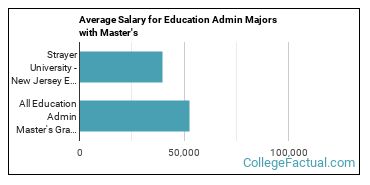 by our College Data Analytics Team
by our College Data Analytics TeamEducational Administration is a major offered under the education program of study at Strayer University - New Jersey. Here, you’ll find out more about the major master’s degree program in education admin, including such details as the number of graduates, ethnicity of students, related majors and concentrations, and more.
You can jump to any section of this page using the links below:
In 2019-2020, the average part-time graduate tuition at Strayer University - New Jersey was $553 per credit hour for both in-state and out-of-state students. The following table shows the average full-time tuition and fees for graduate student.
| In State | Out of State | |
|---|---|---|
| Tuition | $14,940 | $14,940 |
| Fees | $195 | $195 |
The median early career salary of education admin students who receive their master’s degree from Strayer University - New Jersey is $39,626 per year. That is 25% lower than the national average of $52,816.

If you’re interested in online learning, you’re in luck. Strayer University - New Jersey does offer online classes in its education admin master’s degree program. To see if the school offers distance learning options in other areas, visit the Strayer University - New Jersey Online Learning page.
*The racial-ethnic minorities count is calculated by taking the total number of students and subtracting white students, international students, and students whose race/ethnicity was unknown. This number is then divided by the total number of students at the school to obtain the racial-ethnic minorities percentage.
More about our data sources and methodologies.